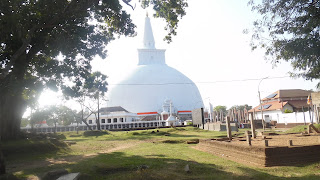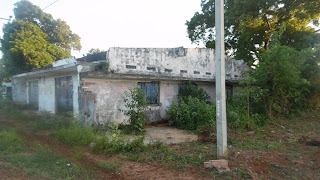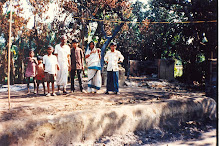Sri
Lanka: Brutal War and Path to Reconciliation
Sachi
G. Dastidar
In the winter of 2017 I
was invited to visit the beautiful tear-drop island beyond the southern tip of
India. I visited the tree-lined capital Colombo in the western Arabian Sea
coast. The city contains ancient Buddhist and Hindu temples, Christian churches
and Islamic mosques as well as British colonial buildings and post-colonial
architecture of modern Sri Lanka. During my stay I visited the holy Buddhist
city of Anuradhapura in the center of the island which is a former capital of Sri
Lankan kingdoms. Further north I traveled to Jaffna, the heartland of the
minority Tamil and Hindu population in the Buddhist-and-Sinhalese-majority
nation. In Sri Lanka demand for discrimination-free equal treatment for the
quarter of the nation – the Tamils – led to a protracted civil war lasting for
more than three decades until the extreme Liberation Tigers of the Tamil Eelam (LTTE)
was defeated by the military of Sri Lanka with massacre of tens of thousands.
With the election of a new pro-reconciliation government in Colombo and
minority Tamil-based parties in power at provinces Sri Lanka as a nation and
Tamil-majority areas are in the process of normalcy. Once you enter the
Tamil-majority areas one sees presence of security on roadside yet traffic
moves freely mostly without any stoppage, also one sees new homes – often
standing next to destroyed ones as reminders of the long war and its cost. Long-time
Tamil pacifist activists Kandiah and Sashi, Jayashingham, Swamiji, Dr. Thiru,
or members of the old All Ceylon Hindu Congress, whether in Colombo or in
Jaffna, are looking to reconciliation as well as peaceful, tolerant and
pluralistic Sri Lanka. Scores of
refugees who returned from refugee camps in Tamil Nadu State of India tell
visitors how lucky they are to survive the war, and how lucky they feel getting
a new home built by poorer India. The bastion of Tamil nationalism is the City
of Jaffna on the northern tip of the island seemed to be bustling and busy with
new investments – a sign of returning normalcy. People are eager to reconcile.
Still at times strangers will mention “how our boys are still rotting in
prison in Colombo and no one has been held responsible for the killing of
thousands of innocent civilians after LTTE surrender and during the war.” Yet
the same individuals said “in the name of our Lord Murugan we must look to a
brighter future and a prosperous nation.” In Colombo majority Sinhala-Buddhists
expressed relief that the “war” has come to an end. They too are looking for a
happier future. To them Jaffna is too far away, not only geographically but
also emotionally.
In Sri Lanka Tamil
speakers follow Hinduism, Christianity and Islam. The beautiful Red Mosque in
Colombo has schedules written only in Tamil and English. A concerned Muslim
said “after the war many Muslims are turning away from their Tamil roots for
majority Sinhala. Most Tamil Muslims didn’t support Tamil Hindu-Christians’ drive
for autonomy or independence thus receiving disdain from Tamil nationalists.
Ruling Sinhala-Buddhist elites have also used religion to create division
within minority Tamil population,” the concerned Muslim alleged.
In Jaffna one Lakshmi
Devi, a small trader in her fifties wearing a battered brown sari, said
gratefully “we first fled to Colombo (from the north to south) to escape
constant bombing, then we were flown to India without any visa and passport, and there we
stayed for years in a refugee camp in southern Tamil Nadu State. We were fed
and clothed there. Once the war was over Sri Lanka government allowed us to
return, and the government of India helped us with rebuilding our home in the
city. That is where we live now. The shop is a result of that! We are grateful
to India. But the war cost us my young son’s life. He died in a bombing ….”
Then she gave a goodbye with folded hands.
Here are a few pictures
from the trip:

A Hindu Temple in Colombo of Sri Ponnambalawanesrar
Statue of Hindu Monk-Reformer Swami Vivekananda
Islamic Red Mosque in Colombo
Anuradhapura
Jaffna Hindu Temple
Destroyed Home
Rebuilt Home
Hindu Holy Site on the Northern Tip of Sri Lanka
Causeway connecting North Sri Lanka
Night Life at Jaffna
Rehearsal for the Jaffna University Convocation
An Orphanage at Jaffna
Mrs. Lakshmi Devi's Shop
At a Hindu Temple
Comments:
Very well written Sachi! I really like the way you wrote. Can you label the pictures?
Thanks for sharing 
Shiyama Varadarajan; February 2, 2017
Thank you,Sachiji
Very interesting
Nice presentation
Neelakandan; February 3, 2017















































1 comment:
Though the country progressed very fast, the scars still remain. Maybe, another generation is needed to come out of it but there seems to be a radical mindset of "Singhale", an emblem of domination is slowly creeping in trying to give a silent yet threatening message to the other ethnic population...
Post a Comment